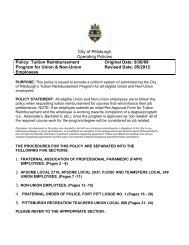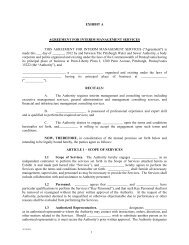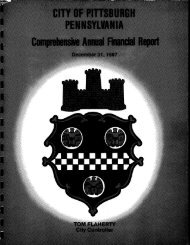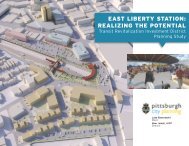Allegheny Commons - City of Pittsburgh
Allegheny Commons - City of Pittsburgh
Allegheny Commons - City of Pittsburgh
You also want an ePaper? Increase the reach of your titles
YUMPU automatically turns print PDFs into web optimized ePapers that Google loves.
United States Department <strong>of</strong> the InteriorNational Park Service / National Register <strong>of</strong> Historic Places Registration FormNPS Form 10900 OMB No. 10240018 (Expires 5/31/2012)<strong>Allegheny</strong> <strong>Commons</strong>Name <strong>of</strong> Property<strong>Allegheny</strong> County, PACounty and StateThe park’s integrity <strong>of</strong> materials, design, and workmanship derive from the execution <strong>of</strong> its landscape planning,the continuity <strong>of</strong> its plantings, and the existence and quality <strong>of</strong> buildings, structures, sites and objects whichcommunicate the park’s historic functions as a place <strong>of</strong> outdoor recreation (both passive and active) andcultural remembering. In these respects, the park has good integrity to all eras <strong>of</strong> its history. The form <strong>of</strong> thepark – its basic boundaries, cross-cut by the railroad and Ohio Street, and its overall path system – date fromMitchell and Grant’s original plan, as does the park’s overall character: the symmetrical formality <strong>of</strong> linearNorth, East, and South <strong>Commons</strong>, linked to the pastoral expanse <strong>of</strong> West Common. Successive campaigns <strong>of</strong>park improvement in 1935 and in 1967 tinkered with, but did not substantially alter, the ways in which thepark’s four quadrants were designed to be experienced by pedestrian users. The swimming pool, pool house,and tennis courts are evidence <strong>of</strong> the <strong>City</strong>’s early- to mid-20 th century emphasis on active recreational facilities.The streamlined path layouts <strong>of</strong> North and lower East <strong>Commons</strong>, which date to the Civil Works Administrationfundedimprovements designed by Ralph Griswold in 1934, also have integrity to this period. While introducinga modern design vocabulary to West Common, Simonds and Simonds’ 1966 plan also resurrected LakeElizabeth, an original feature <strong>of</strong> the park whose function has evolved from ornamental to recreational toornamental again, after a 20-year period <strong>of</strong> nonexistence. West Common’s meandering, pastoral characterhas its origins in Mitchell and Grant’s original 1867 plan, while extant features such as the lake, its concretearched footbridges, the mounded earth, and the brick perimeter walls have integrity to the Simonds plan <strong>of</strong>1966.Plantings from all periods are present and are true to the original park designers’ intent, with formal alleesemphasizing linear features and more informal specimen plantings filling in lawns and meadows. Among thetrees and parklands, the park’s first 50 years saw an accumulation <strong>of</strong> monumental furnishings, such hasfountains and sculptures. The fountains were gradually removed as their maintenance became burdensome tothe <strong>City</strong> and the park’s emphasis on ornamentation shifted to one <strong>of</strong> recreation during the 20th century. Yetmany major monuments and sculptures from the Victorian period remain: the Hampton Battery Memorial, theSoldier’s Monument, the Thomas Armstrong Memorial, George Washington Memorial, Maine Memorial, andiron deer sculpture. These contribute not only to the park’s integrity <strong>of</strong> materials, design, and workmanship,but to its feeling and association as a repository <strong>of</strong> cultural memory and political commemoration. Likewise,bridges erected to facilitate the interaction <strong>of</strong> the park’s multimodal transportation systems – pedestrian paths,vehicular roads, and a railroad which predated the park itself – are still extant with integrity (although theircondition currently is poor). No buildings from the park’s first 50 years survive, but two from the park’s secondera as a recreational destination (the pool house and restroom building) do, also with integrity. Of the park’stwo non-contributing buildings, the maintenance building has little impact on the park’s overall integrity since itis tucked into an out-<strong>of</strong>-the way location. The Aviary, though a primary presence in the park, does not presenta major barrier to integrity because its location has always been the site <strong>of</strong> a city-owned institution, from thepenitentiary to the former conservatory. Its use is compatible with that <strong>of</strong> the park, and its siting does notrepresent a removal <strong>of</strong> park land.Together, the park’s unchanged location, its strong and consistent boundaries, its largely intact setting, and thepresence <strong>of</strong> its contributing buildings, structures, sites, and objects – including the park as a site, itself –contribute to its integrity <strong>of</strong> feeling and association. The park’s green lawns and extensive tree canopycontinue to represent a verdant oasis within a densely-built area <strong>of</strong> <strong>Pittsburgh</strong>. Its surrounding street wall <strong>of</strong>19th and early 20th century buildings, combined with its gentle topography, its lush and varied plantings, itsfocal nodes occupied by historic statuary, its reflective water feature, and the presence <strong>of</strong> recreationalresources, cumulatively communicate <strong>Allegheny</strong> <strong>Commons</strong>’ history as an ornamental Victorian park whichevolved to meet the wants and needs <strong>of</strong> the city it served over its first 100 years. Intact paths, roads, andbridges underscore the park’s essential identity as a public work, a <strong>City</strong>-built pleasure ground which mustnevertheless accommodate the urban region’s industrial and transit functions. Only two noncontributingsculptures, unobtrusively sited, intrude on the feeling <strong>of</strong> Victorian commemoration supplied by the park’scontributing monuments and memorials. Active recreational features such as ball courts and the swimming11
















